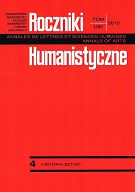Symbolika dzieł sztuki z wyposażenia sali sądowej trybunału koronnego w Lublinie w świetle osiemnastowiecznych kazań
The Symbolic Meaning of the Court Room Equipment. The Case of the Crown Tribunal in Lublin as Shown in a Selection of 18th-Century Sermons
Author(s): Krzysztof GombinSubject(s): Cultural history
Published by: Towarzystwo Naukowe KUL & Katolicki Uniwersytet Lubelski Jana Pawła II
Keywords: symbolic content; work of art; Crown Tribunal; symbolika; dzieło sztuki; trybunał koronny
Summary/Abstract: The sermons addressed to the deputies during Church festivities and celebrations were part of the customary functioning of the Crown Tribunal. These texts disclose a lot of information that are of paramount value for an art historian. This particularly pertains to 18th-century texts. As borne out by the sermons under analysis, two items of equipment in the Tribunal courtrooms communicated a specific symbolic and legal message: these were the Tribunal cross and the portrait of St. Thomas, the Apostle. The sermons frequently compare the Christ’s ultimate judgments to the rulings of the Polish court. The message behind the symbol of the Tribunal cross was even more intense if it was part of a Marshall’s or a President’s court-of-arms. This was the case in 1723, when Micha³ Potocki of Pilawa was the Marshall. The most intriguing fusion of events depicted in the New Testament and the Old Polish reality is to be found in a sermon by Wojciech Zabielski, a Jesuit, where he used the figures taking part in the Way of the Cross as models to depict acts and attitudes of his contemporaries. The sermons present St Thomas as a witness to Christ’s resurrection who needed to prove the truth of the redemptive miracle by means of his senses. He symbolized the scrutiny and meticulousness in search of truth and decent judgement. He was set as an example for the judges, who should be ready to lay down their lives for truth and justice.
Journal: Roczniki Humanistyczne
- Issue Year: 58/2010
- Issue No: 04
- Page Range: 147-160
- Page Count: 14
- Language: Polish

